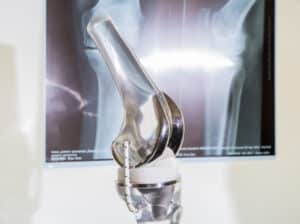 ☰ Menu
☰ Menu
Nearly 800,000 Americans undergo total knee replacement surgery every year. More than 90% of these surgeries are successful and complication-free; knee implants can last over 20 years.
Part of the secret of the success of knee implants is the variety of options available. If you are considering knee implant surgery, an orthopedic surgeon can discuss your options to help you find the perfect knee replacement. Here are some options to help you start thinking about the possibilities. After your consultation, you can also refer to this list to refresh yourself on some of the options you discussed.
First, it’s important to consider how much of the knee you will replace. Your knee surgeon might recommend either partial knee replacement or total knee replacement. Total knee replacement is by far the most common.
Partial knee replacement just replaces the highest-stress area of the knee joint. The thigh bone has a shape like the generic dog treat bone, with two lobes on the end that are at the knee. In partial knee replacement, we replace one of these lobes, along with a corresponding surface on the shin bone, and (usually) put a cushion between the two. Part of the kneecap may also be replaced in the process.
In the past, only a few people were considered eligible for this surgery, but modern technology makes it feasible in more cases.
In a total knee replacement, we replace the entire touching surface of both bones and (usually) put a cushion between them. Not much of the bone is replaced, just enough to fully protect the bone and secure the implant. In addition, a part of the kneecap may be replaced.

Two cruciate ligaments stabilize the knee: the anterior cruciate ligament (ACL) and the posterior (PCL). In partial knee replacement, both the ACL and the PCL are retained. Generally, both the PCL and ACL must be in good shape for you to be a candidate for partial knee replacement. In cruciate-retaining total knee replacement surgery, the PCL is retained to continue stabilizing the knee. Cruciate-retaining knee implants are sometimes called non-constrained implants.
Posterior-stabilized knee replacements, also called semi-constrained implants, use artificial structures to perform the function of the PCL. Most of the time, these designs still rely on ligaments on the sides of the knee to maintain lateral stability, but sometimes, the knee stabilization structures are redesigned to help with this task, too.
A hinged knee replacement, or constrained knee replacement, uses a simple hinge to replace the knee. This type of knee implant is sturdier but less flexible than other types.

Metal on plastic is the most common composition of knee implants. These have the longest track record for safety and function, and their general longevity is due to the durability of these materials.
For people with metal sensitivity, it might be best to avoid metal knee implants. Metal sensitivity is uncommon, but some estimates place it as high as 10% of the population. Let your knee replacement specialist know if you’ve ever poorly reacted to metal, from costume jewelry to dental restorations.
If you have had a bad reaction to metal, your knee replacement surgeon may recommend testing to determine if it’s necessary to avoid metal knee implants. Ceramic on plastic knee implants don’t have as long a safety record as metal implants.
Because some people react negatively to the worn-down plastic components in knee implants, your knee replacement surgeon might recommend an implant without plastic cushioning parts. For ceramic components, this would mean an implant where ceramic rubs ceramic.
Metal on metal implants are sometimes used to avoid plastic wear in implants and the related potential toxicity. In this case, it’s especially important to know whether you have metal sensitivity because these implants experience more metal shavings than other types, which can cause complications in the knee joint.
If you are considering knee replacement options on the Western Slope, Colorado Advanced Orthopedics will deliver the exceptional outcome you deserve. Our knee replacement specialist, Dr. Kevin Borchard, performs all our knee surgeries using the Mako Robotic-Arm Assisted Surgery System, and his technique gives our patients results that exceed industry standards.
According to the data collected by Stryker Medical, Dr. Borchard’s patients spend less time in the hospital and can walk further than 90% of knee replacement patients at discharge. In addition, to date, 100% of Dr. Borchard’s patients are released directly from the hospital to home without going to a rehabilitation center. Most importantly, Dr. Borchard is proud to have zero orthopedic surgical site infections among his knee replacement patients.
Contact us today to schedule an appointment. Colorado Advanced Orthopedics serves patients in Meeker, the White River Valley, and the Western Slope.
Subscribe to our monthly newsletter for the latest tips and insights on orthopedic health, wellness, and recovery. Discover how to celebrate life to the fullest!
Subscribe To Our Monthly Publication